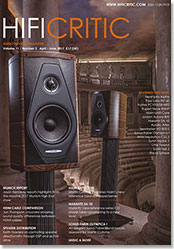|
|
| Home | High-End Audio Reviews | Audiophile Show Reports | Partner Mags | Hi-Fi / Music News | |
|
|
Celebrating 30 Years Of Service To Music Lovers |
Digital Music And Online Music Streaming
Editorial By Paul Messenger
It might be more than fifty years since Bob Dylan originally wrote that 'the times they are a changing', yet that phrase is arguably even more relevant to the music business today. Sure, analogue vinyl will continue to steam on regardless, but the various digital sources are constantly evolving and coming up with new solutions. Indeed, one reason behind this editorial was a misunderstanding in the (virtual) office over naming the latest digital sources.
From the mid-1980s and for twenty or thirty years thereafter, Compact Disc was really the only digital audio game in town. However, as computer memories expanded and internet speeds increased, various alternatives presented themselves. In its early days computer audio gained a poor reputation, due to MP3 digital compression and the practice of 'pirate' file-sharing.
However, as internet speeds increased, the downloading of high resolution files became a reality. And at around the same time, hi-fi-oriented 'servers' started appearing as an alternative to the CD player. By connecting them to a home network with internet connection, comprehensive information can then be accessed using a smartphone or tablet, and the latter also controls the server. The idea is therefore to put one's complete collection of CDs and other music files onto the server, primarily to improve access to the music.
The server may have its roots in computer technology, using a built-in hard disk (or solid state) drive, but it's dedicated to 'ripping', recording and replaying music files to a hi-fi standard. Some may have built-in DACs, outputting stereo analogue signals for feeding to a conventional integrated amplifier or (pre-amp). Others may output digital music files, usually via S/PDIF connection, whereupon some form of external DAC will be required. This might be a standalone item, be built into amplification, or indeed some other component such as a streamer (or network music player as it's also known).

The streamer is the latest digital audio device to appear (see feature on P48). In some ways it may be regarded as an extension from internet radio, albeit with software-based feedback from the receiver to the source. It essentially consists of tapping into a large and comprehensive library of music files that is stored on a server well away from the home network and accessed via the internet. Once again, a DAC may often be required to convert the digital datastream music file into the required stereo analogue signal, again separate or built-in.
Streaming first began when Spotify was launched nearly a decade ago, as either a free service with advertisements, or a subscription service without. Numerous rivals with various different offers have since appeared, arguably the most interesting being Qobuz and Tidal, which seem to be more sound quality oriented than the others. New services continue to appear, and existing ones increase the quality of their offerings.
My personal preference remains vinyl-oriented, though this may well be because my large collection dates back to the mid-1960s. And although I still find the sound quality of streaming a trifle 'sub analogue', I am impressed by the size of the libraries, as well as the convenience of the whole operation. Streaming vs vinyl is not an either/or thing, as the various means of accessing music are complementary, not conflicting. All add to the experience, as well as helping one to discover new music to enjoy.
– Paul Messenger
Editor
Subscribe!
![]()
Click
here to subscribe to HIFICRITIC

 High-Performance Audio Reviews
High-Performance Audio Reviews


















